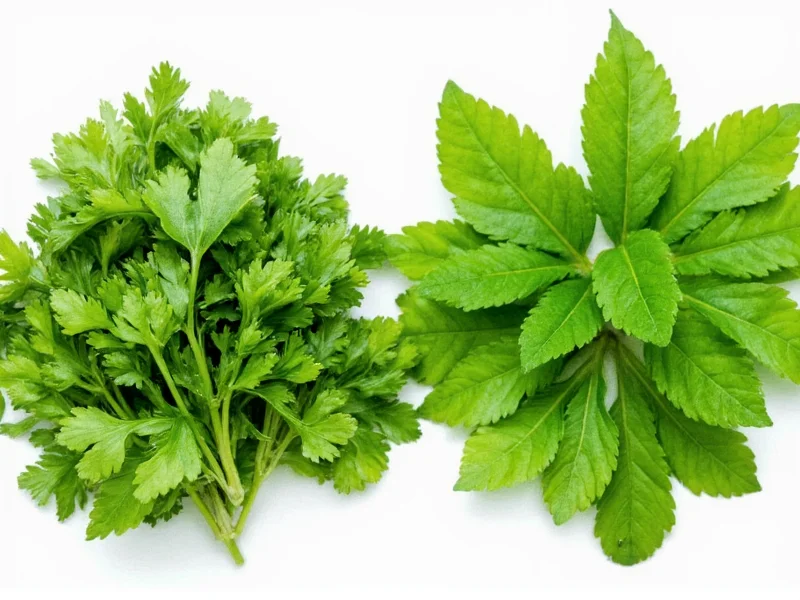When standing in the grocery store holding two nearly identical bunches of leafy green herbs, many home cooks face confusion: Is cilantro the same as flat-leaf parsley? This common culinary dilemma stems from their visual resemblance, but understanding the critical differences between these herbs can transform your cooking experience and prevent recipe disasters.
Botanical Classification and Origins
Despite their similar appearance, cilantro and flat-leaf parsley belong to different botanical classifications. Cilantro (Coriandrum sativum) is the leafy part of the coriander plant, which produces the spice known as coriander seeds. It originates from regions spanning Southern Europe, North Africa, and Western Asia. Flat-leaf parsley (Petroselinum crispum neapolitanum) is a specific variety of parsley that falls under the broader Petroselinum crispum species, with origins tracing back to the Mediterranean region.
The confusion between these herbs largely stems from regional naming differences. In many parts of the world, particularly in the UK and Europe, "coriander" refers to both the seeds and the leaves, while in North America, "cilantro" specifically denotes the fresh leaves. This naming discrepancy contributes significantly to the cilantro vs flat leaf parsley misunderstanding.
Visual Comparison: Spotting the Differences
While both herbs feature flat, serrated leaves on thin stems, careful observation reveals distinguishing characteristics:
| Characteristic | Cilantro | Flat-Leaf Parsley |
|---|---|---|
| Leaf Shape | Rounded, almost circular with deeper serrations | More elongated, oval-shaped with shallower serrations |
| Leaf Texture | Softer, more delicate texture | Firmer, slightly tougher texture |
| Stem Color | Pale green to whitish | Brighter, more vibrant green |
| Overall Appearance | More compact growth pattern | More open, spreading growth pattern |
Flavor Profiles: A Culinary Divide
The most significant difference between cilantro vs flat leaf parsley lies in their flavor profiles. Cilantro delivers a bold, citrusy punch with distinctive soapy notes that approximately 21% of the population perceives due to a genetic variation (OR6A2 gene). This polarizing flavor makes cilantro essential in Latin American, Southeast Asian, and Indian cuisines.
Flat-leaf parsley offers a milder, more neutral grassy flavor with subtle bitter notes. Chefs often describe it as having a clean, fresh taste that complements rather than dominates dishes. Unlike its curly counterpart, flat-leaf parsley has a slightly more robust flavor that holds up better in cooking.
Culinary Applications and Substitution Guidance
Understanding when to use each herb prevents culinary mishaps. Cilantro shines in dishes where its distinctive flavor enhances the overall profile:
- Salsas and guacamole
- Ceviche and other raw seafood preparations
- Curry bases and chutneys
- Fresh garnishes for Mexican, Thai, and Vietnamese dishes
Flat-leaf parsley serves as a versatile culinary workhorse:
- As a primary component in gremolata and persillade
- In bouquet garni for soups and stews
- As a finishing herb for Mediterranean dishes
- In tabbouleh and other grain salads
When considering whether you can substitute flat leaf parsley for cilantro, the answer depends on the dish. In cooked applications where cilantro's flavor diminishes, flat-leaf parsley might work with added citrus to mimic cilantro's profile. However, in raw applications like salsa or guacamole, substituting flat-leaf parsley for cilantro creates a fundamentally different dish that misses the authentic flavor profile.
Storage and Handling Best Practices
Both herbs require similar storage methods but have different shelf lives. To maximize freshness:
- Trim the stems and place in a glass with 1-2 inches of water
- Cover loosely with a plastic bag
- Store in the refrigerator
- Change water every 2-3 days
Cilantro typically lasts 5-7 days under these conditions, while flat-leaf parsley often remains fresh for 7-10 days. For longer storage, chop and freeze both herbs in ice cube trays with water or olive oil. Never store either herb in airtight plastic bags without ventilation, as this accelerates spoilage.
Common Misconceptions Clarified
Several persistent myths surround the cilantro vs flat leaf parsley debate. The most common misconception claims they're regional names for the same herb. This is categorically false—they're botanically distinct plants. Another widespread error suggests that young cilantro resembles flat-leaf parsley, but mature plants maintain their distinctive characteristics regardless of growth stage.
The confusion intensifies because some grocery stores mislabel these herbs, particularly in regions where cilantro is less commonly used. Always verify by smelling the herbs—cilantro emits a distinctive citrus aroma while flat-leaf parsley has a more neutral, grassy scent.
Genetic Factors in Cilantro Perception
Scientific research reveals that approximately 21% of people possess a genetic variation (OR6A2 gene) that causes cilantro to taste like soap. This genetic predisposition explains why some individuals vehemently dislike cilantro while others enjoy its distinctive flavor. Flat-leaf parsley doesn't trigger this genetic response, making it a more universally accepted herb across diverse palates.
This genetic factor significantly impacts the cilantro vs flat leaf parsley substitution question. For those who perceive cilantro as soapy, flat-leaf parsley with added lime juice sometimes serves as an acceptable alternative in certain dishes, though it won't replicate authentic flavors.











 浙公网安备
33010002000092号
浙公网安备
33010002000092号 浙B2-20120091-4
浙B2-20120091-4